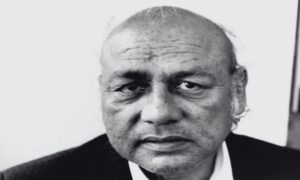In this piece, Muhammad Shehryar reviews the latest book which has been compiled and edited by Pakistan’s former top ambassador; Maleeha Lodhi.
If you take a closer look at the history of Pakistan and the current situation, you will see Pakistan falling into a never-ending pit. If we look at the history of Pakistan, our rulers have preferred to compete with each other instead of the country. When Pakistan got independence, the conditions and security of our country were not good, but at that time, our leadership was strong and determined. Build dams in the face of harsh conditions, bring economic stability and strengthen security. The turning point in Pakistan’s political history came when the military imposed martial law, and they too became addicted to power. It is a pity that our leaders do not have a political manifesto that benefits the country but instead blames their opponents for shining their future politics.
Pakistan’s nature and character have never been more intense than today; some demand Pakistan as a theocratic state and others for a Democratic state. Some of the religious groups demand Sharia as state rule (Taliban is the extreme expression of it), and others argue that Islam has nothing to do with the affairs of the state.
Jinnah, in his speech, expressed the secular nature of the state where everyone is allowed to their religious worship sites. The Jinnah ideas about Pakistan remained vague, though vagueness was both the strength and weaknesses of the state movement. During his last days, he began to sharpen the Idea of Pakistan. He travelled extensively and spoke tirelessly on the radio and in public. Quaid e Azam supported Pakistan under high principles laid down by the prophet of Arabia in the seventh century. Although Jinnah had pointed out the flaws in the western-style democracy, it was still the best system of government available to Muslims.
Pakistan’s crises are due to governance that the country has faced in the past and is still facing. The other factors are Asymmetry in power because of political and non-political institutions. The most important crises are its clientelist politics. Now economic crises also prevent Pakistan from growing and developing; the main factor is low tax collection, and the tax to GDP ratio has remained static over decades. The economic management that relied on someone else’s money permitted the country’s rulers to avoid much needed structural reforms that could have placed the economy on a viable, self-reliant path. This showed the extent to which the ruling elite had come to see outsiders on catalytic agents to solve their problems. After these critical crises, Pakistan again started moving on a clear and beneficial path. During 2000–2007, Pakistan’s economy grew at an average of 6-7 per cent a year, making it one of the fastest-growing Asian economies. The size of the economy doubled while per capita incomes increased from $ 527 in 2000 to $ 925 in 2007 (over $ 1,250 in 2009).
The author beautifully explains the Musharraf era; the Army’s role in civil governance also explains Talibanization, its function, and its impact on Pakistan foreign policy. They also discuss the operation conducted in Fata and how the war on terror knocked on the door of Pakistan.
Pakistan’s political and bureaucratic system is useless and inefficient; according to the survey of FPSC, more people now coming from lower classes and select police services it seems that they are attracted to the political clientelist system. The political personals lack political charters that they have to follow; they are waiting for God and have not been successful in constricting a party system or promoting Democratic values.
This book also touches on the ideological drift. What role has Islam played in Pakistan evolution, has the issue of religion that has been used for multiple objectives -from nation-building strategic security – produce a deadly blowback that is now confronting Pakistan with unprecedented challenges. The author emphasis on the matter that how Islam is used as leverage against India and how Pakistan was separated, and how they declared Ahmadi’s as non-Muslims and Fatima Jinnah was prevented from political affairs, saying that Islam doesn’t allow females to rule; such propaganda was also used against Benazir Bhutto.
Zahid Hussain, in his chapter (Battling Militancy), comprehensively explains the rise and fall of the militants, The role of Jamaat e Islami in establishing religious units in politics and their support towards al Qaeda, Tehreek-e-Taliban Pakistan while the first Pakistan jihad group emerged in the 1980s by 2002 the country had become home to twenty-four militant groups.
Transparency in the actions of the government can be achieved by several means, i.e. hearings of Parliamentary Committees, question hours in the National and Provincial Assemblies, Freedom of Information Act, removal of several clauses of the Official Secrets Act, the introduction of e-government and investigative reporting by competent and responsible journalists. Most of these measures exist but more in form rather than substance. In India, however, the Right of Information Act is bringing about a silent revolution, and civil society is using access to information to expose corruption in public places and secure the rights of the poor. The bureaucrats have become more cautious as their actions are open to public scrutiny. In Pakistan, excessive misuse of newly acquired power by some media representatives in assassinating the character of political leaders or public servants without substantiation or evidence may prove to be more detrimental to the cause of disclosure and transparency.
Education plays an essential role in the development of a country. In Pakistan, education is an expectation builder, but Pakistan is far away from education due to economic crises and political disturbance. The main problems of education in Pakistan are.
- Failure to provide Education, there are fewer institutions in the country for education. Half of the people are illiterate; the country has the second-highest number of out-of-school children worldwide.
- The second failure is to provide quality education.
- Failure to provide a livelihood.
In his chapter (Reversing strategic shrinkage), Munir Akram explains Pakistan fighting TTP, pacifying Afghanistan, Reviving the economy, the pervasive challenges from India, the cost of counter-terrorism, the road ball to strategic assertion and the matter of Kashmir. Kashmir remains vital for Pakistan for multiple reasons.
- Muslim majority area.
- Territory of an area bigger than Belgium.
- People ethnically, religiously, culturally and historically linked to the people of Pakistan rather than India.
- Strategy: The only direct land link to Pakistan’s ally, China.
If you want to know Pakistan policies towards Afghanistan and how Pakistan achieves its goals by using Afghanistan as a buffer state, Here you will know Pakistan behaviour towards India due to the Kashmir issue and the conducting of terrorist plans in Balochistan and how India blames Pakistan for terrorist attacks in India. In this book the nuclear proliferation is also explained comprehensively and why Pakistan chose nuclear weapons in their hard time.




